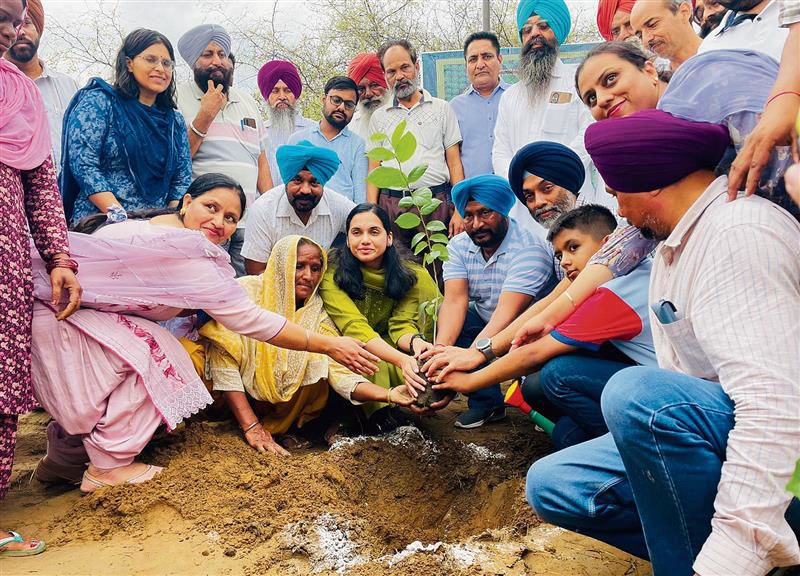Coming, green colleges, varsities, corridors along roads in Ludhiana district
Nitin Jain
Ludhiana, July 13
Colleges and universities would have green campuses and roads and highways would have green corridors on both sides in the district.
This and much more is coming up under the “Wake-up Ludhiana for a liveable tomorrow” initiative aimed at transforming the industrial and financial capital of Punjab into a green, sustainable, and climate-resilient city.
The development assumes significance as Ludhiana is among the country’s 20 most polluted cities. It had figured among 20 most polluted cities in the country in a latest study.
Brainchild of Deputy Commissioner Sakshi Sawhney, this ambitious and holistic initiative has already got wings with the plantation of a record 1.87 lakh saplings during a daylong plantation drive launched by Chief Secretary Anurag Verma here on Friday. A total of 15 lakh saplings would be planted in the district this monsoon.
Sakshi, who is holding the charge of the MC Commissioner and GLADA Chief Administrator, told The Tribune, here on Saturday that the objective of the plan would be to foster green campuses and raise environmental consciousness among students.
“Moving towards green campus, the initiative would ensure 20 per cent green cover on all college/ university campuses by implementing vertical gardening and landscaping to meet the targets,” she said.
Sakshi said the green committee being set up would identify areas for greening, ensure fulfilment of planting targets and plan future green cover expansion. It will engage students and faculty members of the colleges/universities and hold regular meetings to implement plans for increasing green cover and other projects related to environmental sustainability.
“The administration would also launch a green internship programme for students to actively participate in the green initiatives,” she announced.
The DC said the departments of Agriculture and Forests would be roped in to promote urban forestry and sustainable agricultural practices.
A tree planting scheme would work to ensure “3 trees per tubewell” with separate tracking and monitoring.
She divulged that it would also promote green canopy cover in urban roadsides to cut urban heat islands.
The administration would also implement the “Guru Nanak Bagichi” urban forestry scheme to ensure community participation.
Under this, the departments would coordinate with each other to identify suitable areas within the district for setting up micro urban forests and increase green canopy cover.
The construction departments such as PWD, NHAI, GLADA, and Improvement Trust would integrate greenery into infrastructure projects.
“To develop green corridors, we would ensure that all roads, bridges, and roadsides have mandatory green cover through vertical greenery corridors,” Sakshi said while stating that vacant spaces would be identified and developed miniature parks and vertical parks along roadsides.
Seeking community participation, the administration has announced to support self-help groups (SHGs) producing green products and coordinate green initiatives.
“We would identify and market SHGs producing green products and coordinate with other departments for implementing the Guru Nanak Bagichi scheme,” she said.
Roping in industries for a sustainable future, the programme would encourage industries to adopt green practices and support the initiative.
Under this plan, the industries would conduct self-audits on their environmental practices and receive recognition from the district administration.
“Citizens would be exhorted to plant at least three trees in their vicinity or adopt vertical gardening,” the DC-cum-MC Chief said while announcing that a tree ATM would be operated with the help of local NGOs from where people would be able to order trees free of cost.
Religious institutions would also be engaged in the initiative by introducing saplings as “boota prasads” to devotees, encouraging tree plantation as a community practice. For the purpose, religious leaders would be facilitated with the distribution of saplings and promoting environmental stewardship.
Monitoring and evaluation
Green dashboard, an online platform, would track and display the progress of all green initiatives, accessible to the public for transparency.
Number of trees planted, solar energy generated, water harvesting systems installed, transition to e-offices and green cover area would be updated regularly.
Review mechanisms
Monthly review meetings would be held with the green city task force and quarterly progress reports would be shared with stakeholders and the public.
A comprehensive annual assessment would be undertaken to evaluate the impact of initiatives and make necessary adjustments.
Partnerships and funding
NGOs and educational institutions would collaborate for technical support and volunteer mobilisation. CSR programmes would be engaged for funding and expertise in implementing green technologies. Funding through government grants and community-based crowdfunding campaigns would also be worked upon.
Will engage public
The district administration will promote tie-ups between industries, educational institutions and government departments to support the citizens’ initiative, which would engage the public in creating a greener Ludhiana. — Sakshi Sawhney, Deputy Commissioner









